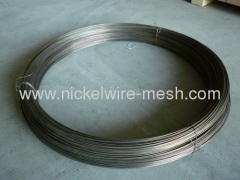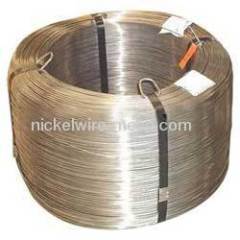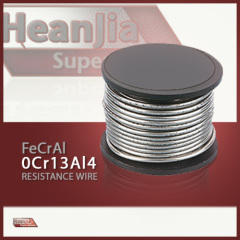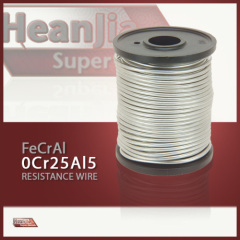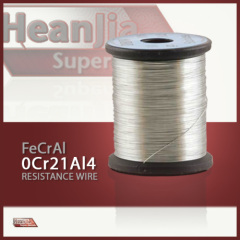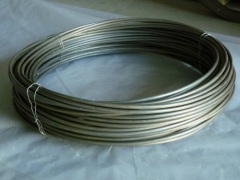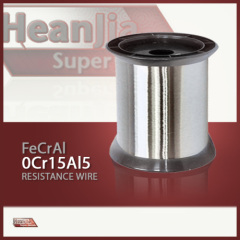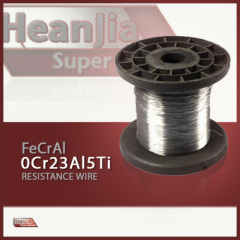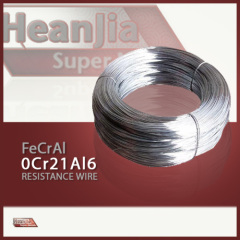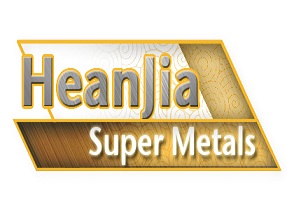
|
Heanjia Super-metals Co., Ltd.
|
FeCrAl Electrical Resistance Wire
| Payment Terms: | T/T,L/C,D/A,D/P,WU |
| Place of Origin: | Hebei, China (Mainland) |
|
|
|
| Add to My Favorites | |
| HiSupplier Escrow |
Product Detail
FeCrAl resistance wire: superior oxidation resistance, lower raw-material cost, density and thermal expansion coefficient than Ni base super alloys
FeCrAl Electrical Resistance Wire
FeCrAl Electrical Resistance Wire has high resistance, low temperature coefficient of electric resistance, high operating temperature, and good corrosion resistance under high temperature, especially under the atmosphere containing sulfides.
FeCrAl Electrical Resistance Wire possesses good oxidation and heat resistance.This kind of resistance wire is creep-resistant over a wide range of temperature, which is another of their important qualities.Ithas several potential advantages, such as lower raw-material cost, superior oxidation resistance, lower density, and lower thermal expansion coefficient than the Ni-base super-alloys.
FeCrAl Electrical Resistance Wire has less hot strength than nickel s but much higher melting point and lower price. After being heated the Resistance Wire's plasticity becomes bad, easy brittleness, not to be easy to weld. However, If can be reasonably used, also be a kind of ideal electric heating material.
FeCrAl Electrical Resistance Wire is made of iron chromium aluminum base s containing small amounts of reactive elements such as yttrium and zirconium. The high aluminum content, in combination with the high chromium content causes the scaling temperature to increase up to 1425 C (2600F ); FeCrAl Electrical Resistance Resistance Wire s also have excellent oxidation properties at 800-1300° C because of the formation of a highly protective Al2O3 scale.
FeCrAl Electrical Resistance Wire Applications:
FeCrAl Electrical Resistance Wire intended for prolonged operation at high temperature. This series of resistance wiresare used chiefly for heating elements in the electrical industry and wide range of high-temperature oxidation environments, such as industrial electric furnace, heating furnace, nuclear reactor, petroleum refinery and automotive exhaust system, household electrical appliance, electrical oven, electrical heater, infrared settings and far infrared ray device. Because ofFeCrAl Electrical Resistance Wire' ability to withstand oxidation, the Resistance Wires can be employed under high-temperature conditions, while their good ductility enables them to be processed into Resistance Wire and Resistance Wire by hot and cold working.
Type | 1Cr13Al4 | 0Cr25Al5 | 0Cr21Al6 | 0Cr23Al5 | 0Cr21Al4 | 0Cr21Al6Nb | 0Cr27Al7Mo2 | |
Main Chemical composition | Cr | 12.0-15.0 | 23.0-26.0 | 19.0-22.0 | 22.5-24.5 | 18.0-21.0 | 21.0-23.0 | 26.5-27.8 |
Al | 4.0-6.0 | 4.5-6.5 | 5.0-7.0 | 4.2-5.0 | 3.0-4.2 | 5.0-7.0 | 6.0-7.0 | |
Re | opportune | opportune | opportune | opportune | opportune | opportune | opportune | |
Fe | Rest | Rest | Rest | Rest | Rest | Rest | Rest | |
Maximal Temperature (°C) | 650 | 1250 | 1250 | 1250 | 1100 | 1350 | 1400 | |
Resistivity 20°C (10-6ohm*m) | 1.25 | 1.42 | 1.42 | 1.35 | 1.23 | 1.45 | 1.53 | |
Density(g/cm3) | 7.4 | 7.1 | 7.16 | 7.25 | 7.35 | 7.1 | 7.1 | |
Thermal conductivity (KJ/m*h*°C) | 52.7 | 46.1 | 63.2 | 60.2 | 46.9 | 46.1 | 45.2 | |
Extend strength (a*10-6/°C) | 15.4 | 16 | 14.7 | 15 | 13.5 | 16 | 16 | |
Melting point ( °C) | 1450 | 1500 | 1500 | 1500 | 1500 | 1510 | 1520 | |
Tensile strength(N/mm2) | 588-735 | 630-780 | 637-780 | 630-780 | 637-784 | 650-800 | 680-830 | |
Extension rate% | >16 | >12 | >12 | >12 | >12 | >12 | >10 | |
Section shrink rate (%) | 65-75 | 60-75 | 65-75 | 65-75 | 65-75 | 65-75 | 65-75 | |
Repeatedly bending frequency (F/R) | >5 | >5 | >5 | >5 | >5 | >5 | >5 | |
Specific heat J/g. | 0.49 | 0.494 | 0.52 | 0.46 | 0.49 | 0.494 | 0.494 | |
Linear expansion coefficient a×10-6/201000 | 15.4 | 16 | 14.7 | 15 | 13.5 | 16 | 16 | |
hardness (H.B.) | 200-260 | 200-260 | 200-260 | 200-260 | 200-260 | 200-260 | 200-260 | |
Rapid life h/ | ≥80/1250 | ≥80/1300 | ≥80/1300 | ≥80/1300 | ≥80/1350 | ≥80/1350 | ||
Microstructure | Ferrite | Ferrite | Ferrite | Ferrite | Ferrite | Ferrite | Ferrite | |
Magnetism | Magnetic | Magnetic | Magnetic | Magnetic | Magnetic | Magnetic | Magnetic | |
Wire Further Processing | Cut to length Wire |
Flat Wire | |
Square and Shaped Wire | |
Rewinding and spooling | |
Polishing and cleaning |
Didn't find what you're looking for?
Post Buying Lead or contact
HiSupplier Customer Service Center
for help!
Related Search
Alloy Electrical Resistance Wire
Resistance Wire
Electrical Resistance Wires
Nichrome Resistance Wire
Heat Resistance Wire
Stranded Resistance Wire
More>>




